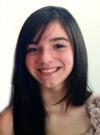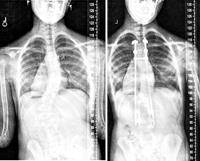Treatment
Patient Story: Scoliosis Treatment With Growing Rods

Most elementary school aged children take playing sports and running around with their friends for granted. Eleven year old Natalie Helm, however, has to take a more cautionary approach.
Diagnosed with idiopathic scoliosis at age 7, Natalie has been dealing with back pain and spinal issues for over a quarter of her young life. A routine physical revealed a severe curve in her spine. To help slow the progression of her spinal curves, Natalie wore a Wilmington Brace, a form-fitting brace covering her entire torso, up to 18 hours a day for two years.
In 2008, Natalie had her first back surgery, called a laminectomy, to remove part of her vertebra and release a potentially tethered spinal cord. Natalie's spinal deformity continued to progress, and in 2009, John Flynn, MD, a pediatric orthopaedic surgeon at the Children's Hospital of Philadelphia, decided a more aggressive approach was necessary.
Dr. Flynn installed "growing rods" on Natalie's spine. Commonly used in young children, these special rods allow for continued controlled growth of the spine. Rods are attached to the spine above and below the spinal curve with screws. The screws are then turned to lengthen the expandable rods and surgically extend her spine during a procedure required every six months. This is done through an incision that is a few inches long, cutting through the muscles that run along her spine each time.
"Through research and pioneering innovation, these temporary implants now prevent the spinal deformity from becoming so severe at an early age that it compromises pulmonary function and can lead to an early death," Dr. Flynn explains. He has performed this surgery on children as young as 18 months in order to save their lives. Without these developments in treating spinal deformities in children, they would have had no chance of survival. "Fortunately, Natalie's scoliosis is not as severe as many of my other growing rod patients, so she did not have to have the rods implanted so early in life."
Since the implementation of the growing rods, Natalie has had four lengthening procedures, the most recent which was in December of 2011. The progression of her scoliosis has largely been contained; however she will need spinal fusion surgery in two years as she approaches puberty.

"Surgery is not fun, but it has made me a stronger person," Natalie says. "It has taught me to be more patient and accepting of things in my life that I cannot control." Natalie has not been permitted to participate in collision sports since her surgery. Although she is taking a break from softball and cheerleading, Natalie has started taking art classes and enjoys dancing and listening to music. She is currently serving her second term as her class student government representative, and also is active in her church as an alter server.
Slowly, Natalie is beginning to participate in physical education again at school. The surgery has improved her self esteem, and now she stands taller and more proud. Through her ordeal, Natalie has honed her skills in compromising and patience. "My greatest challenge is assuring Natalie that she will go on to live a normal adult life and that scoliosis will not define who she is," her mother Christine says.
The Helms believe that additional research is a critical component in early intervention. "Research can help better the lives of people with scoliosis by developing better surgical techniques, therapies and hardware," Christine states. "Research can help make these types of surgeries safer for younger children and also more accessible to patients."
Last Reviewed
October 2012
AAOS does not endorse any treatments, procedures, products, or physicians referenced herein. This information is provided as an educational service and is not intended to serve as medical advice. Anyone seeking specific orthopaedic advice or assistance should consult his or her orthopaedic surgeon, or locate one in your area through the AAOS Find an Orthopaedist program on this website.






